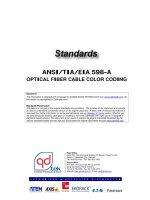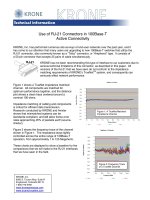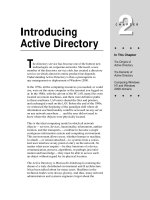Tài liệu ADX Active Digital Cross-Connect A Space in Time pptx
Bạn đang xem bản rút gọn của tài liệu. Xem và tải ngay bản đầy đủ của tài liệu tại đây (222.77 KB, 4 trang )
WHITE PAPER
ADX Active Digital
Cross-Connect
A Space in Time
ADX
Active Digital Cross-Connect
Mobile operators in Europe are being squeezed on several fronts, not least of which is
space. Explosive growth from popular voice services has forced them to continuously
increase the capacity of their backhaul networks consisting largely of leased lines that
connect to terminating multiplexers. Increasingly, space is becoming precious—and
expensive—real estate in remote cabinets housing this equipment.
For many operators, acquiring additional space is not an option either because of the
associated cost of leasing expensive housing cabinets or because of public opposition
to new cabinets on roofs and in other areas. Clearly, the answer for these operators is
to make better use of existing space. One quick and cost-efficient solution is to deploy
space-saving technology, such as ADC’s compact active digital cross-connect (ADX),
which reduces the amount of 2 Mbps leased line cables in the exchange while, at the
same time, increasing flexibility through efficient multiplexing.
Numerous GSM (Global Service for Mobile Communication) operators in Europe offering
2G (second-generation) circuit-switched mobile services recognize a need to solve their
space dilemma sooner than later. Demand for their voice-centric service continues to
grow explosively. In fact, penetration in large markets such as Germany, France, Italy and
the United Kingdom now exceeds 80 percent, with the Nordic countries approaching the
100 percent mark.
Voice remains the killer application
Even if new broadband mobile data services available over packet-switched 3G (third-
generation) networks will eventually capture a larger share of the average revenue
per user (APRU), voice is—and will remain—a killer application. Teenagers, craftsmen,
businesspeople and just about everyone on the go has come to appreciate the ability to
make and receive calls from nearly everywhere on the planet at any time. Accordingly,
networks carrying this traffic will only grow—not shrink.
Such growth, of course, has created networking challenges for mobile operators.
Arguably one of the biggest they face is backhaul. This is the part of the network that
includes the cellular base station at the edge, the base station controller or radio network
controller, and all other layer 1-3 transport, aggregation and switching elements in the
access and metro networks, excluding the core switching network. The infrastructure
connecting all these sites is largely of 2 Mbps E1 leased lines but also includes point-to-
point microwave; it can be expensive to operate and difficult to scale if not efficiently
designed and managed. Today, for example, E1 lines account for as much as 25 percent
of some mobile operators’ operating expenses.
TDM has its advantages
To provide their 2G services, GSM mobile phone operators have built backhaul networks
based on TDM (Time Division Multiplex) technology. TDM-based networks, using SDH
(Synchronous Digital Hierarchy) in their core, have long served as standard transport
platforms for cellular traffic. SDH is optimized to handle bulk voice circuits with
maximum uptime, minimal delay and guaranteed service continuity.
A Space in Time
Early GSM operators chose TDM because of its many
advantages. The technology is time-tested and relatively
simple, enabling operators at any given time to know
what traffic is going over the links. Moreover, TDM-based
networks are ubiquitous. As such, they allow underused
links to be shared through aggregation. An essential
part of any GSM network transport design, aggregation
allows for more efficient use of the transport bandwidth
and simplifies network management.
Generally speaking, aggregation occurs where there is
dense concentration of traffic from multiple radio cell
sites, typically at the controller sites and the mobile
switching center (MSC). As voice traffic increases—and
this has been the case in Europe and nearly all GSM
markets around the world—the quantity
of backhaul links rises exponentially.
Aggregation of traffic invariably leads to
lower opex (operating expenses).
TDM-based networks can deliver
significant cost reductions providing
that the multiple traffic streams are
aggregated intelligently. A TDM
multiplexer, for example, can merge
several E1 leased lines to carry traffic
over an STM-1 link (Synchronous Transfer
Module), which becomes cost-effective.
Time division multiplexing requires
fewer switching ports and less expensive
equipment. For example, an STM-1 port
costs less than a 63x E1 port card on a
switch. Also, using higher speed modules
allows for higher port density in the same
device. The elimination of all these costs
helps reduce capex (capital expenses).
Dealing with unknowns
Certainly, mobile operators face significant unknowns as
they plan how to transport growing volumes of traffic
over the next four to six years. One is the challenge
created by new 3G services, requiring high bandwidth
at low cost. Another involves the radio access, which
is evolving to encompass a much broader set of
technologies, making new demands on the transport
network of the future.
At the same time, mobile operators can no longer
predict, with any degree of certainty, their future
backhaul requirements, as those requirements will
constantly change in unforeseeable ways. Today, they no
longer have a firm, predictable base to plan their capacity
and technology requirements.
Given all this, mobile operators need to develop a
transport solution that adapts to their changing needs
in a flexible, cost-efficient way. This process begins with
the identification of key backhaul segments and focus on
the areas to be optimized within each network segment.
All phases in the network’s lifecycle, from planning and
implementation to maintenance and upgrades need to
take these factors into account.
Operators can deal with increased uncertainty by using
technology that offers high flexibility and scalability, and
provides a cost-effective route to grow their networks.
The ADX Active Digital Cross-Connect is a smart way
to tackle a complex issue in the backhaul network by
overcoming space restrictions in distribution cabinets.
Its compact design fits into all profile rod or rack-mount
systems, reducing space by 50 percent to 80 percent.
Equally important, the system can eliminate huge bundles
of copper cable running to distribution frames.
The ADX brings together two traditionally separated
worlds by combining the cross-connect flexibility and
transparent test access of a DDF (Digital Distribution
Frame) with the switching capability of a multiplexer.
In one unit, the system combines a very compact SDH
add/drop multiplexer (ADM), up to 64 accessible E1
ports, optimal STM-1 aggregation ports, E1 cross-connect
and a DDF. It complies with SDH standards and supports
operation and administration features required for
successful integration into an existing transport network.
The ADX, which resides at the edge of the remote
exchange, is designed to perform various tasks. For
instance, it allows all incoming E1s to be aggregated into
one piece of equipment and then fed into the E1 routers.
If some or all of the E1 traffic must be redirected through
to a specific router, this can be done remotely, shortening
the amount of time required to make service changes.
In addition, the ADX multiplexes all E1 lines into a single
fiber, which then connects directly to an SDH multiplexer
as a fiber pair rather than as a bundle of 63 copper pairs.
This unique feature offers substantial space saving.
ADX Active Digital Cross-Connect – A Space in Time
Page 3
The ADX 100 shown in a “cable gainer” application; eliminates large bundles of
copper cable.
WHITE PAPER
Size does matter
The size of the ADX itself is ideal for remote sites
with tight space restrictions. The system fits into
the slot typically used for the copper distribution
frame block.
The ADX is available in three compact models:
the ADX 100 mounts on profile rods, includes the
STM-1 card, and supports eight interface cards
with eight E1 ports each; the ADX 200 mounts in
a 19-inch rack, is one rack unit high and supports
four interface card slots (up to 32 E1 interfaces);
the ADX 201 mounts in a 19-inch rack, is two
rack units high and supports eight interface card
slots and up to 64 E1 interfaces.
Technical specifications
The maximum power consumption when IFCs and
SFPs are inserted is < 14 W.
In addition to its space-saving design, the ADX has
several other advantages. For instance, the ADX
is designed to run on low energy. Because the
product uses little energy, it also creates little heat,
requiring fewer ventilators and fewer climatisation
control elements. Lower power consumption
means lower power costs and thus lower opex.
Moreover, the ADX supports E1 unframed
transport and is transparent for framed E1 signals.
It also supports the ability to perform nonintrusive
monitoring of any connection at the E1 level,
similar to the conventional distribution frames.
Monitoring is possible on the test access output or
any other E1 port.
The ADX cross-connect functionality offers any-
to-any non-blocking connectivity and eliminates
the need for manual jumpering. Dispatching
technicians to manually move or change jumper
cables in remote sites is a huge cost factor. The
reduced need for technician intervention also
reduces opportunities for human error.
At the same time, the ADX increases flexibility
by allowing service assignment changes to be
done remotely. At the same time, record-keeping
for these changes is moved from technicians
maintaining physical records to the network
management system automatically compiling this
data.
Lower opex and capex = lower TCO
In summary, the ADX is designed to meet the
growing bandwidth needs of mobile operators for
their voice-centric services. The product enables
more flexible assignment of E1 leased lines inside
edge network applications through uniquely
integrated E1 cross-connect functionality. It also
optimizes capacity through STM-1 connections.
The net result is lower capex and opex, and thus
lower TCO (total cost of ownership).
Clearly at a time when mobile operators are
challenged to predict future transport demands on
their networks, the availability of technology such
as the ADX, which offers calculable functionality
and costs, promises much-needed relief.
WHITE PAPER
Web Site: www.adc.com
From North America, Call Toll Free: 1-800-366-3891 • Outside of North America: +1-952-938-8080
Fax: +1-952-917-3237 • For a listing of ADC’s global sales office locations, please refer to our Web site.
ADC Telecommunications, Inc., P.O. Box 1101, Minneapolis, Minnesota USA 55440-1101
Specifications published here are current as of the date of publication of this document. Because we are continuously
improving our products, ADC reserves the right to change specifications without prior notice. At any time, you may
verify product specifications by contacting our headquarters office in Minneapolis. ADC Telecommunications, Inc.
views its patent portfolio as an important corporate asset and vigorously enforces its patents. Products or features
contained herein may be covered by one or more U.S. or foreign patents. An Equal Opportunity Employer
103259AE 8/06 Original © 2006 ADC Telecommunications, Inc. All Rights Reserved
ADX100 ADX200 ADX201
Height 244 mm 44 mm 88 mm
Width 140 mm 450 mm 450 mm
Depth 120 mm 180 mm 180 mm
Weight
1.7 Kg (excluding
interface cards)
1.7 Kg (excluding
interface cards)
2.5 Kg (excluding
interface cards)
Power
Consumption
6.5 W (excluding
interface cards)
6.5 W (excluding
interface cards)
6.5 W (excluding
interface cards)









